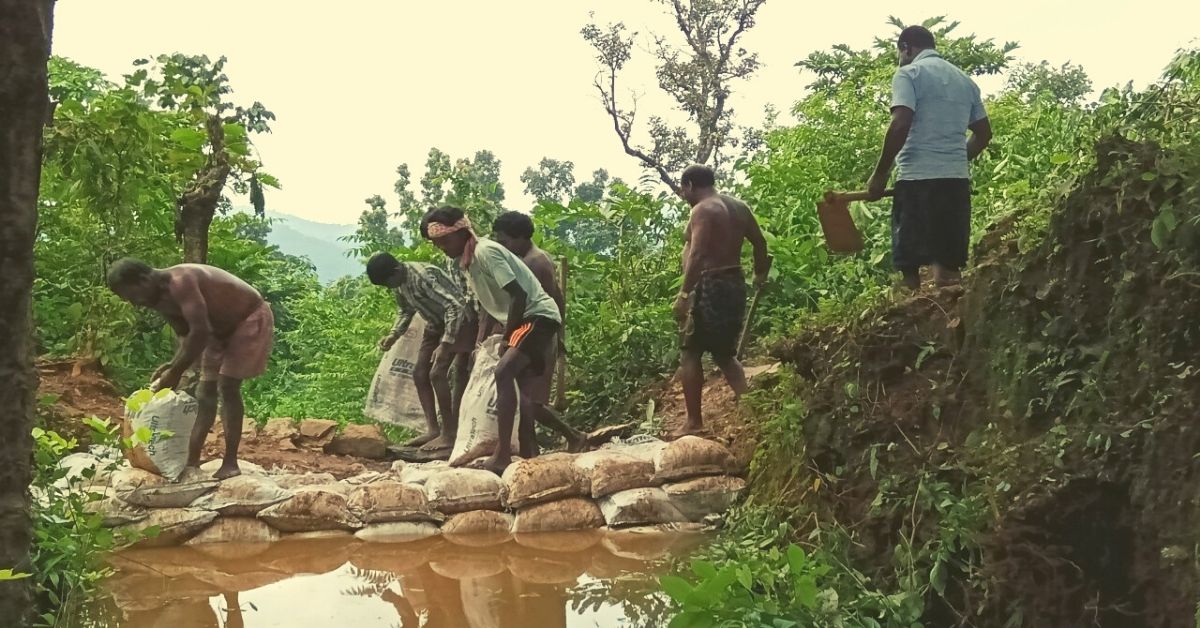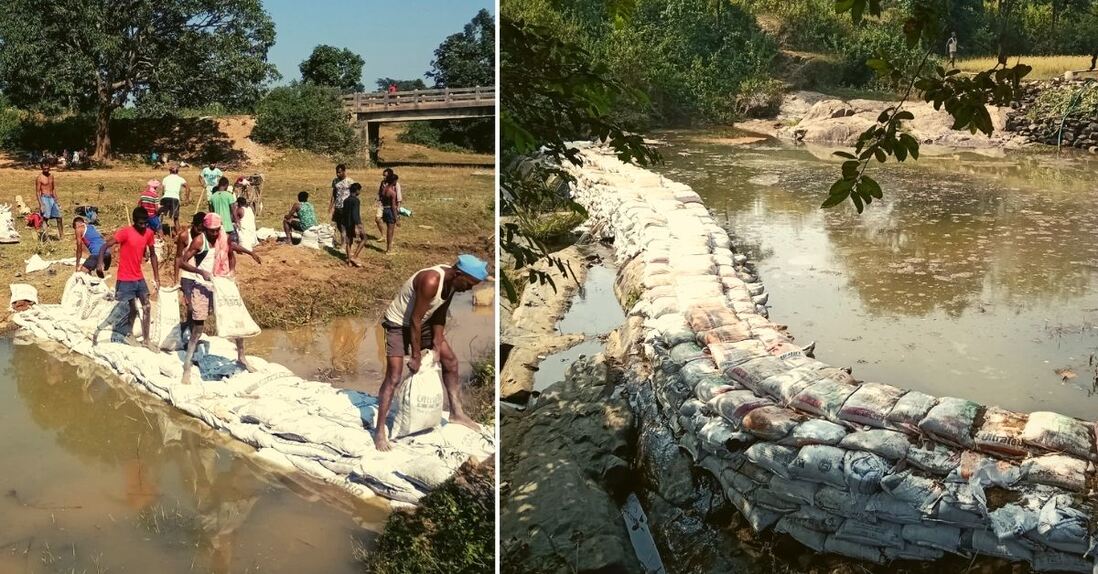Jharkhand IAS Officer’s Water Harvesting Model is 99% Cheaper, Helps 8000 Farmers
“For survival, our people would literally scale mountains and carry several litres of water over their shoulders. But, things are changing for good now.”

35-year-old Laxman Mathur has been farming for the past 14 years in a small village called Pelaul, in the interiors of Khunti district, Jharkhand. Unlike his two elder brothers, he decided to continue their family legacy of agriculture, after completing his graduation in Economics. The only thing that drove him to farming at the time was passion.
“As farmers we are doing an essential service for the society that often gets ignored. Farmers tend to struggle in the cycle of poverty, but with the right technology, planning and aid from the government, this can change for good. I wanted to delve into that area and prove that farming can be lucrative through various sustainable practices,” he says.
However, a few years into farming, he realised the common problem ailing all the farmers of the region was a lack of adequate water supply. Despite having 10 rivers flowing through the region, most farmers only managed to grow kharif crops and suffered low irrigation efficiency.
Explaining the situation, former deputy commissioner Suraj Kumar says, “The soil in the district is extremely fertile and the rainfall is also sufficient and yet most farmers have had to resort to mono-cropping. This was because, despite good rainfall, there is a problem of run-off in this plateau region that amounts to low irrigation efficiency. By the end of the kharif season, there would be no water left for agriculture due to run-off , let alone the daily water needs for survival.”
Realizing the need for change, Suraj with his team and an NGO, Sewa Welfare Society, started the bori bandh project in 2019, to build low-cost check dams across the district that can easily retain water for irrigation. Today, under this project the community has built over 250 low-cost check dams that directly impact the lives of over 8,000 farmers by helping them grow crops all around the year across thousands of acres of land.
Retaining water to waste management

Khunti’s current deputy commissioner, Shashi Ranjan, in conversation with The Better India said that their water conservation and sustainable irrigation model is a two-fold solution that not only addresses the region’s water woes but also contributes to waste management.
“We needed to make our solution sustainable and cost-friendly as funds were tight. So instead of employing a conventional check dam system, we decided to use an innovative technique of creating an obstruction using sand and mud-filled sacks. All these sacks were recycled plastic cement bags sourced at a nominal cost of Re 1 per bag from local dealers. In some cases, many even donated the bags. This way we were not only helping change the course of flowing water to aid in efficient irrigation but also were recycling plastic waste,” he says.
The bori bandh is constructed as a wall of these soil and sand-filled bags that are stacked neatly on top of one another to stop the water from flowing into rivulets. This water is then used in agriculture as well as various other purposes like drinking, cooking, cleaning, etc.
Another very important feature of the project was also to enhance social harmony through community involvement. Being a Naxal-affected area, Khunti has witnessed its own share of socio-political struggle that over the years, had pushed the people away from each other.
A social worker and president of Sewa Welfare Society, Ajay Sharma says, “In the bori bandh project, we made sure that the people of the villages, especially the farmers were actively involved. So community participation through shramdaan (voluntary donation of human resources through labour) was crucial. By the end of each workday, we even made sure to organise a community kitchen to provide meals to all who had helped in making the bori bandh possible. This not only helped people get personally involved in the process of their own
development but also brought the overall cost of installation down considerably.”
Impact

In addition to an increased water supply owing to the rising level of water in wells and borings, the bori bandh project had many more positive consequences. It has been a total game-changer for both established farmers as well as small and marginal farmers.
Speaking about that Shashi says, “Now that the water was available all around the year the farmers began to successfully start growing various other crops like vegetables and fruits even in the rabi season. Plus, the rate of migration or displacement due to lack of employment opportunities in the villages after the kharif season, began to reduce. More farmers, especially the marginal farmers, then began to solely focus on agriculture as their primary source of income.”
From paddy, wheat, mustard to sweet corn, watermelon and various other vegetables and fruits began to flourish in their fields with the help of bori bandhs. Ajay adds that a single bori bandh had the capacity to irrigate 10 to 20 acres of land while also taking care of other water needs. Some farmers even began to start fish farming in the bori bandhs in addition to their usual irrigation needs.
According to Suraj, while a small bori bandh can support almost 20 farmers, a big bori bandh can sustain 40 -50 farmers at a time. During his tenure, he further installed solar pumps in 3 bori bandhs to push the water further to cover at least 2.5 kilometers more. In post-COVID-19 situation, Shashi hopes to replicate this in many other blocks as well. Till date, more than 250 bori bandhs all around the district.
Shashi adds that this model is self-sustainable although the life of a bori bandh is approximately two years. “Compared to a check dam that can cost between Rs 4 to Rs 25,00,000 depending on the size, a bori bandh costs Rs 2,000. Although heavy rains over a prolonged period can affect the bandhs, it can be easily rebuilt post the rainy season on a negligible cost.”
One of the beneficiaries, Laxman adds that the farmers, having already built a few bori bandhs, are now confident about independently carrying out the maintenance or construction in case these are swept away by heavy rainfall. “It is not even a disadvantage as we are now empowered to take care of our bori bandhs all on our own,” he says.
A dream of a new Khunti

Their exemplary work in this Naxal-affected district recently found recognition through an award of excellence from the Union Jal Shakti ministry. The award under the participatory water management category was presented to Shashi who has vouched to continue the legacy of transformation started by Suraj. Back in June 2020, Khunti also won the prestigious Skoch award for their efforts in water management.
“It was a very proud moment for Khunti as the credit for its improvement solely goes to its people. We were the facilitators, but through community participation and local involvement of gram sabhas and panchayats we were able to accomplish this feat across 3 blocks and 30 panchayats of the district.” He plans on undertaking many more such constructions and by the end of this year hopes to complete building bori bandhs in 30 to 35 more panchayats.
“We live in the land of Birsa Munda whose slogan of Jal-Jungle-Jameen reiterates the importance of natural resources in this same order. There was a time when despite the natural abundance, we would struggle for every single drop of water. For survival, our people would literally scale mountains and carry several litres of water over their shoulders. By the end of the journey, they would be exhausted with their bodies perspiring more than the water they had just carried. The acres of dry and barren land would represent the image of perpetual thirst for water our people once felt. But this is changing now and I am happy to be a part of it,” concludes Ajay.
(Edited by Sandhya Menon)
If you found our stories insightful, informative, or even just enjoyable, we invite you to consider making a voluntary payment to support the work we do at The Better India. Your contribution helps us continue producing quality content that educates, inspires, and drives positive change.
Choose one of the payment options below for your contribution-
By paying for the stories you value, you directly contribute to sustaining our efforts focused on making a difference in the world. Together, let’s ensure that impactful stories continue to be told and shared, enriching lives and communities alike.
Thank you for your support. Here are some frequently asked questions you might find helpful to know why you are contributing?


This story made me
-
97
-
121
-
89
-
167











